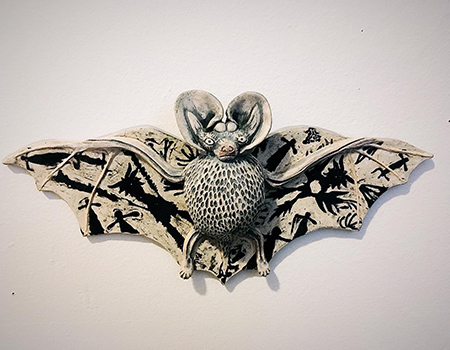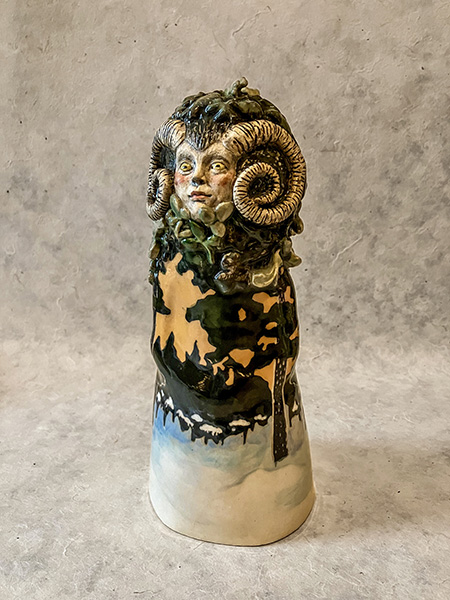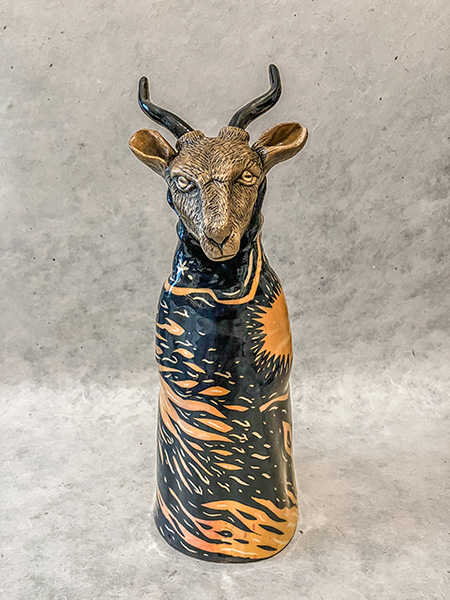MAGGIE PUCKETT
home
artist statement
cv
contact
Born 1981, Long Beach, California, USA
Lives and works in Chicago, Illinois, USA
Investigating ecofeminist themes through papermaking, printmaking, artist's books, ceramics, and painting. Read More
.....................................................................................
maggie.puckett@gmail.com
Instagram: @maggiepuck
.....................................................................................
|
Future Folklore Future Folklore is a mixed-media body of work at the intersection of science, folklore, and feminism. A response to climate change, the work updates historical, patriarchal folklore around seasons, animals, and plants to meet the challenges of a warming planet. Imagining an alternative, ecofeminist folklore for the inhabitants of a hotter planet with more extreme weather and increasing social unrest. Future Folklore draws inspiration from Scandinavian and northern European mythology about the plants, spirits, and rituals of the darkest days of the year. These stories include a host of characters including ancient winter deities, belly-slitting witches, abusive goat-men, and elves who will ride you to the underworld; a bestiary of boars, bucks, and spectral dogs; an herbal of mystical plants and psychedelic fungus; all playing out on a the snowy slopes of frozen mountains and the icy shores of arctic islands, under the twinkling lights of the aurora borealis. My work explores how these stories may change as the frozen lands from which they emerged become increasingly warmer. This body of work has been developing over the last several years, merging research from history, ecology, feminism, ethnobotany, and climate science into a mixed media practice including printmaking, artist’s books, hand papermaking, drawing, painting, urban gardening, and most recently, ceramic sculpture. “Future Folklore’’ projects are inspired by powerful female figures of mythology and lore including: Freyja, ancient Norse deity of sex, fertility, war and death; who later morphed into Germanic mythological figure Frigga, and then Frau Perchta, and Spinnstubenfrau, the (flax/wool) “spinning-room lady” who burns unspun fibers; the Barborka/Barborky; Lussi/Lussibrud leader of the WIld Hunt, Lucia, German/Austrian Lutzelfrau who cuts Achilles tendons, and Bohemian beaked Lucka who resembles Schnabelpercht, aka Beak Perchta. Hailing from northern latitudes with extremely cold and dark winters and rugged terrain, the artworks merge landscape, flora and fauna with the central figure, creating an interconnected ecosystem. This interconnected relationship relates to the Gaia hypothesis: Earth as a vast, synergistic, self-regulating organism; where living matter collectively maintains the material conditions necessary for the continuance of life. More simply, Earth is a living organism, or at least it’s extremely helpful to think of her as one, and all our biogeochemical functions and systems contribute to the reproduction of the living Earth superorganism. To me this connects with a pre-industrial conception of nature: a living-earth worldview. Most ancient and medieval societies considered nature to be a living, interconnected organism of which humans were but a part. In late 16th century patriarchal Europe, the Scientific Revolution transformed this organic worldview by disconnecting the parts of living nature, effectively rendering them inert, passive, and ultimately dead. In her book The Death of Nature: Women, Ecology, and the Scientific Revolution, Carolyn Merchant describes how this new mechanistic worldview “functioned as a justification for power and dominion over nature.” This ideological transformation relegated both nature and women to the lower echelons of passive matter; God-given resources to be acted upon and controlled by the white European male. Such a worldview enabled the increasingly intensive resource extraction of early capitalist societies at home in Europe—and their colonial empires abroad—in order to control methods of production and reproduction for the profit of the elite. As capitalism’s plundering of natural resources and human labor continued for centuries, its destructive appetite traversed the globe, irrevocably transforming ecosystems, destroying habitats, reducing biodiversity, and ultimately leading to climate change. The feminist and ecological statements of the work are more important than ever as women’s rights and the health of ecosystems are increasingly being eroded. |
|
|
|
|
 |





